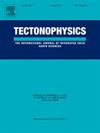Seismicity, seismotectonics and historical earthquakes of the Northwestern Apennines, Italy: A reappraisal
IF 2.7
3区 地球科学
Q2 GEOCHEMISTRY & GEOPHYSICS
引用次数: 0
Abstract
The inner NW Apennines includes the Lunigiana region, which has been shaken by several strong (M > 6.0) earthquakes in the last millenium until the most recent 2013 Mw 5.1, Fivizzano earthquake. In this study we profit from more than 30 years of seismicity and an updated map of the faults to perform a seismotectonic analysis. In order to enlarge our study to the strongest events, we also compute the focal parameters of the 1834 and 1837 earthquakes applying the KF technique to macroseismic intensities. Our findings show that most of the seismicity in the study region is organized in clusters. The southern cluster is oriented nearly E-W and marks the border between the Lunigiana and Garfagnana grabens, NW of the Alpi Apuane. The northern cluster is less limited in size and number of events, and this masks the predominant apenninic NW-NNW orientation. NE of the Lunigiana graben, seismic events align along an apenninic direction as well. On the external side, earthquakes are almost perpendicular to the chain in an NEE-SWW orientation. Cross sections show the existence of three domains along the NE-SW direction. While the external and internal domains are well defined, the domain in between may represent the area in which switching from shortening to extension is ongoing. The processes occurring in this domain entail energies that are at times unleashed as considerable earthquakes, including the notable seismic event of 1834.

意大利亚平宁山脉西北部地震活动性、地震构造和历史地震:再评价
内西北部亚平宁山脉包括卢尼吉亚纳地区,该地区已被几次强烈的地震震动。在最近的2013年,Fivizzano发生了里氏5.1级地震。在这项研究中,我们利用30多年的地震活动和更新的断层图来进行地震构造分析。为了将研究范围扩大到最强地震,我们还应用KF技术计算了1834年和1837年地震的震源参数。研究结果表明,研究区内大部分地震活动呈簇状组织。南部星团接近东西向,标志着卢尼吉亚纳地堑和加尔法格纳地堑之间的边界,位于阿尔卑斯山脉西北部。北部星团在大小和事件数量上的限制较少,这掩盖了亚平宁主要的NW-NNW方向。在鲁尼吉亚那地堑的东北方向,地震事件也沿着平流方向排列。在外部,地震几乎垂直于北东-西南向的链。剖面显示沿NE-SW方向存在3个域。虽然外部和内部领域定义良好,但两者之间的领域可能表示正在进行从缩短到扩展的转换的区域。在这个区域发生的过程需要能量,这些能量有时会以大地震的形式释放出来,包括1834年的著名地震事件。
本文章由计算机程序翻译,如有差异,请以英文原文为准。
求助全文
约1分钟内获得全文
求助全文
来源期刊

Tectonophysics
地学-地球化学与地球物理
CiteScore
4.90
自引率
6.90%
发文量
300
审稿时长
6 months
期刊介绍:
The prime focus of Tectonophysics will be high-impact original research and reviews in the fields of kinematics, structure, composition, and dynamics of the solid arth at all scales. Tectonophysics particularly encourages submission of papers based on the integration of a multitude of geophysical, geological, geochemical, geodynamic, and geotectonic methods
 求助内容:
求助内容: 应助结果提醒方式:
应助结果提醒方式:


